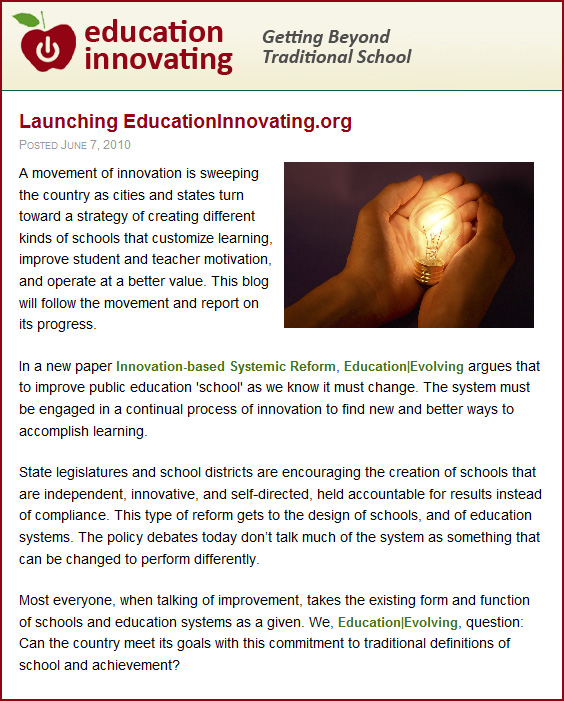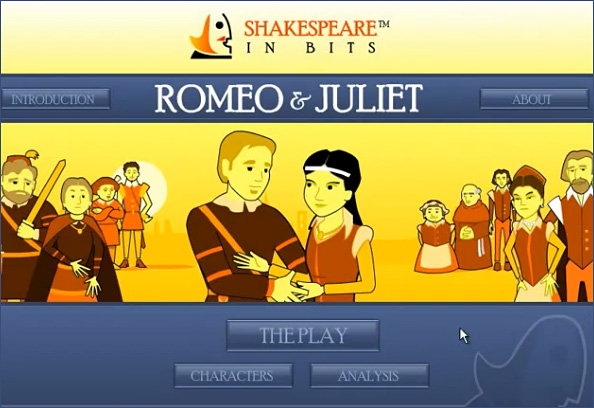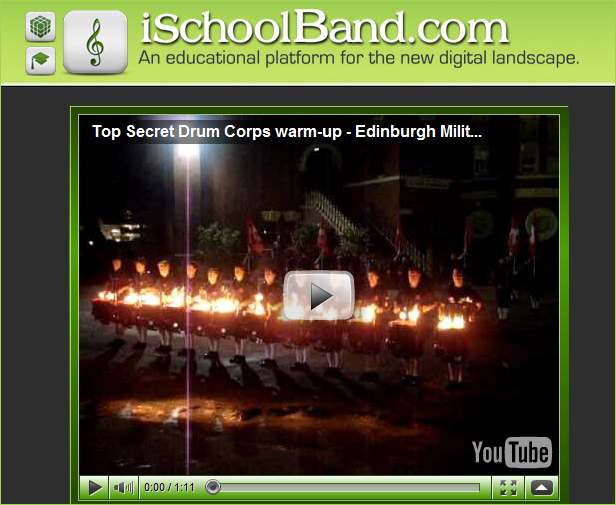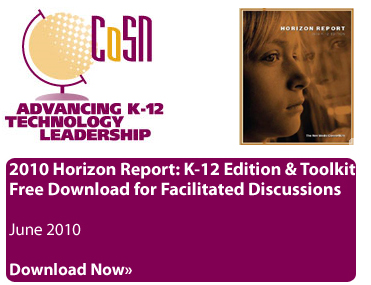.
Developer Website: www.shakespeareinbits.com or Mindconnex Learning Limited
iTunes Link: http://itunes.apple.com/us/app/shakespeare-in-bits-romeo/id370803660?mt=8
Reviewer Name: Elisabeth LeBris who blogs at lebrisary.blogspot.com
Ed-tech innovators share their vision for education — from eSchoolNews.com [via the Ubiquitous Learning Newsletter; see below]
Leaders in education technology offer their insights on the future of education in video interviews with eSN-TV
Ubiquitous Learning Journal, Volume 2, Number 4 now available

The final issue of Volume 2 of Ubiquitous Learning: An International Journal has now been published. Volume 2, Number 4 contains:
- Changes to the Information and Communication Technology Skills of Pre-Service Teachers Over Time by John Kenneth Hope and Anthony Neil Hunt.
- Sustaining Technological Innovation: Is it too Calm after the Storm? by Heather Hemming and Gregory MacKinnon.
- Involving Students in the Development and Evaluation of a Ubiquitous Learning Application for a Design Practice Setting by Lisa-Dionne Morris and Anthea Connolly.
- Dynamic Organizing and Evaluating Project-Based Collaborative Learning by Oleg Tilchin.
- Using a Customized Wiki for Classroom and Online Learning by Arthur Taylor.
- Learning Language, Content, and Collaboration through Group Projects by Paula Korsko, Kate Lyons and Carlos Guevara.
- The Use of Instructional Technology to Impact Student Retention and Attitudes in a College Level Geology Course by Michelle McMahon.
The TEAMS Model: Unifying Arts, Academics, and Career and Technical Education — from Edutopia.org by Betty Ray
Editor’s Note: Today’s guest blogger is Jim Brazell, a technology forecaster, author, public speaker, and consultant. It is the second in a five-part series on the convergence of STEM education and the Arts (TEAMS).
TEAMS in Florida
“We are witnessing a new Renaissance,” Bob explains, “where TEAMS work and disciplines are the key to Florida’s creative enterprise from film to educational technology to medicine.” On Friday, June 18, 2010, Bob Allen spoke to the Florida Association of Arts Education (FAAE) about the importance of integrating technology, engineering, arts, mathematics and science (TEAMS). To Bob, integration of STEM and the arts is a no brainer. Bob is the chief storytelling officer of IDEAS, an innovation studio that was spun out of Disney in Orlando.
Florida is a critical state in terms of TEAMS-based education because cultural and technical arts industries accounted for $28 billion dollars in revenue in 2007 with forecasted job growth exceeding biomedical and defense (as a percentage) between 2008 and 2018 (Harper, 2008). The arts are also viewed systemically in Florida across many STEM high technology industries.
Ohio calls on Blackboard to create statewide online learning clearinghouse — from The Journal by Dian Schaffhauser
Ohio’s Board of Regents will be working with Blackboard in developing a program to host distance learning courses in the state. Chancellor Eric Fingerhut chose Blackboard’s consulting team to build a new, statewide digital learning clearinghouse that will provide a common platform for online courses. The goal of the program is to use the courses to graduate more students, keep more of them at Ohio colleges and universities and in the state’s workforce, and attract more out of state graduates to pursue additional education and careers in Ohio.
Participating schools can both add and tap into the courses offered in the program. High school students could earn college credit through dual enrollment and Advanced Placement courses or use remediation offerings. College students could attend a wider range of courses and other options for earning credits and completing degrees more quickly. The resources are also expected to help adult learners who want to pursue training to advance or change their careers and prepare for certifications.
49 applicants win i3 Grants — from edweek.org
The U.S. Department of Education announced Wednesday that 49 districts, schools, and nonprofits beat out more than 1,600 other applicants in the competition for $650 million in grants from the Investing in Innovation, or i3, fund.
Four groups—the KIPP Foundation, Ohio State University, the Success for All Foundation, and Teach For America—won what are known as “scale up” awards worth up to $50 million each.
Fifteen groups won “validation” awards of up to $30 million, and 30 won “development” grants of up to $5 million.
The winners will focus their work in 250 different project locations spanning 42 states plus the District of Columbia, and 37 percent say they intend to serve rural school districts.
Make Me a Story
Teaching Writing Through Digital Storytelling
.
“Just as writing can be a process of discovery, so can digital storytelling, where images, words, and music all work together to create meaning.” — Lisa Miller
.
Excerpt of contents
Introduction
Chapter 1: Stories That Matter
Chapter 2: How Do Writers Tell (Digital) Stories?
Chapter 3: Taking Students Through the Writing Process, Part 1
Chapter 4: Taking Students Through the Writing Process, Part 2
Chapter 5: Learning Through Digital Storytelling: Standards and Assessment
About the author
Lisa C. Miller is an associate professor of journalism at the University of New Hampshire and has worked on digital stories with elementary school teachers and students.
Michigan’s first virtual charter school selects downtown Grand Rapids site, accepting applications — from rapidgrowthmedia.com
A virtual charter school sponsored by Grand Valley State University will welcome its first students on September 7 at what school leaders say is its first Michigan location – a former office space at 678 Front Ave. NW.
Michigan Virtual Charter Academy, operated by Herndon, Va.-based K12, Inc., will launch with a curriculum geared for high school dropouts ages 17 to 21, offering onsite and online learning in half-day formats.
“It’s a hybrid blend of onsite and online learning, and we’ll have two shifts of students,” says Randall Greenway, vice president of school development. “This was a promising location and it’s close to where we believe our students reside and work. It also has public transportation nearby, and that’s a big part of it.”
K12 Inc. Announces Acquisition of KC Distance Learning, Inc. — from marketwatch.com
U.S. leader in online learning expands offerings for schools and families domestically and internationally
Summer school goes online — from tech.fortune.cnn.com
Educational and Cost Effectiveness: OER vs Traditional Textbooks — from iterating toward openness
…BYU has just received a grant from the William and Flora Hewlett Foundation. The pilot project will examine the deeper learning and cost savings that can be achieved when open textbooks replace traditional, expensive textbooks in public high school science classrooms.
15-20 public high school science teachers in Utah will replace their expensive, traditional textbooks with open textbooks from CK12.org for the 2010-2011 school year. Approximately 2,000 students will be impacted by the changes. Most will use printed versions of the books, while a few hundred students in one-to-one schools will use the online versions of the books on netbooks or iPads. Teachers will continue to supplement the CK12 books with additional resources and activities just as they have historically supplemented expensive, traditional textbooks.
Colleges and the Common Core — InsideHigherEd.com
MINNEAPOLIS — For years, educators and policy makers have been talking about the need to better align K-12 and higher education, so that students coming out of high school have the skills and knowledge they need to do college-level work (and, not unimportantly, to reduce the need for remediation once students are in college).
The establishment of common core standards for high school graduates is of course first and foremost a matter of concern for elementary and secondary school officials, and the creation of the standards is barely on the radar screen of many college administrators and professors. And yet it is clear that the standards will be truly meaningful and useful only if they are fully embraced by higher education.
Only if colleges align their own admissions and placement policies with the common core standards (and agree to use the common assessments that are likely to be developed to gauge mastery of the standards) will high school students and their schools know what to shoot for, Lingenfelter and Wilhoit said. And only if colleges of education begin to reframe their curriculums and practices for training teachers and school administrators and their professional development programs for working teachers in response to the standards will schools have the future work force to carry out the standards.














